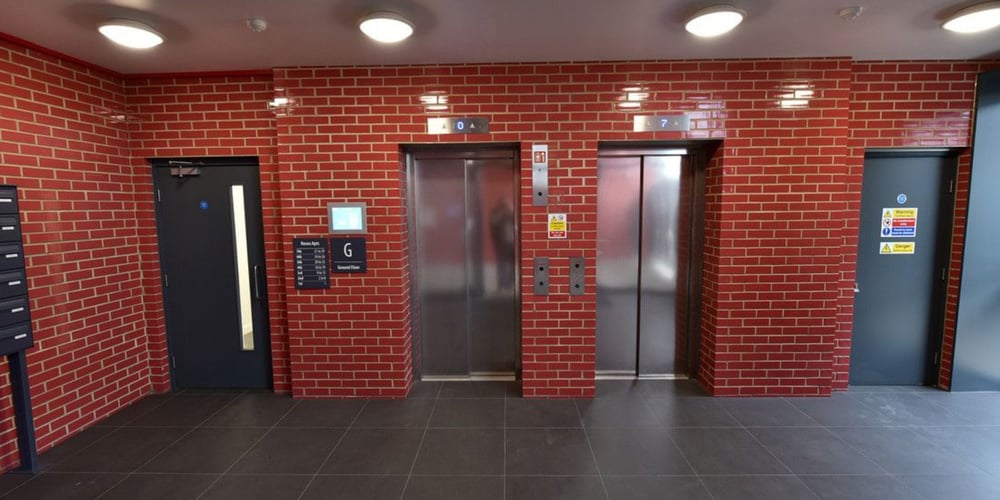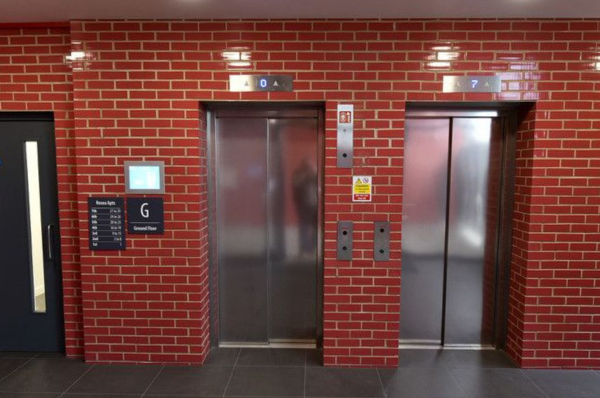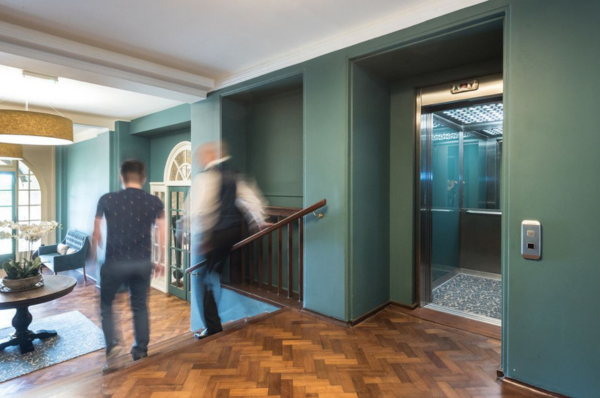Lift requirements in residential buildings UK

A guide on specifying lifts for multi-storey housing developments, from fire fighting lifts to refurbishing existing lifts in a block of flats; the choices are endless.
Tower block lifts – a fascinating history
Multi-story housing developments were restricted to seven storeys before the days of elevators. Wealthy people lived on the ground floor; the poorest people lived on the top floor and so had the most stairs to climb. Social standing reversed with the advent of lifts; the penthouse was reserved for the wealthiest occupants.
High-rise housing became the order of the day post-war, and many of these developments still exist today. Adding lifts to communal areas was vital in this type of development, as without them, accessing the higher floors by staircase would have been too arduous. Today lifts play an essential part in growing public and private housing requirements.
When is a lift required in a residential building - UK advice
Lift requirements in flats (UK) mean a lift should be provided for managed housing over two floors or more to ensure the accommodation is suitable for all occupants, including people with restricted mobility. If there are thirty or more individual units (flats) above the ground floor of the building, then two lifts to support access should always be considered.
This is particularly important in larger blocks of flats where a lift being out-of-action or closed for servicing can cause severe disruption to residents. We’d always recommend installing at least two lifts as best practice.
What types of lifts for tower blocks & flats might be applicable?
Every passenger lift and platform lift we supply to the housing sector has the latest standards. Platform lifts can be supplied and installed in low-rise housing, where they are to be used infrequently by a small number of people and increasingly as an individual solution in a private dwelling.
Part M of the Building Regulations recommends passenger lifts should always be the first choice. For taller or larger residential buildings, one or more passenger lifts should be central in moving people vertically. As part of this, the type of passenger lift requires careful consideration; for example, some lifts may also be used for firefighting and evacuation.
There is also a rise in the installation of goods lifts used to aid underground storage of bikes/bins in residential buildings - driven by a desire for Local Authorities to outline how waste is handled in their areas by waste management plans.
Specifying passenger lifts for multi-storey residential housing
Use the questions below to help you decide what lift you need:
1. The number of lifts required in a residential building and which configuration?
Design guidelines recommend two lifts for any building under BS8300 - Design of an accessible and inclusive built environment - Part 2: Buildings — Code of practice, this helps to enable access provision for all in the event of downtime due to servicing and maintenance or in the unlikely event of a lift failure. Depending on the number of floors, this may mean there is also a requirement for one of the lifts to be a fire-fighting lift.
2. What type of finish do you require?
Lifts should reflect their building, where there is a more robust requirement; vandal-resistant finishes or vandal-resistant lifts can play their part. Two categories of vandal-resistant lifts are covered by the British Standard EN81-71: vandal-resistant lifts. This standard defines the testing methodology and the classification of lifts in terms of vandal resistance.
For any lift requiring a vandal-resistant element, be it category 1 or category 2, primarily, the lift has more vandal-resistant elements than a traditional passenger lift. These elements include (but are not limited to) the following: vandal-resistant and reinforced car and landing doors, finishing the lift car in vandal-resistant heavy-duty stainless steel cladding patterns such as 5WL, leather or linen, vandal-resistant lighting and car roofs built to resist more than 150kg, IP54 push buttons, vandal-resistant displays and car operating panels.
Vandal-resistant lifts category 2 provide twice as much effort to control crushing, shearing, cutting, trapping, impact hazard, electrical and thermal hazard in a lift where there may be occurrences of vandal resistance than a category 1 lift.
For example, at St John's Hill Peabody Housing Estate, the lifts have been specified to match the heavy-duty demand of this environment, with the nine 8-person lifts fitted with higher-grade stainless steel lift cars and Dewhurst push-button controls and a mix of Cat 1 and Cat 2 vandal-resistant lifts (shown below).

Alternatively, do you require bespoke finishes and car sizes for a high-end housing project to ensure the lift properly reflects the investment in interior design?
A luxury or bespoke finish, either in the form of a bare lift car clad to match the rest of the building or glass, marble or wood effect, helps add to the overall sale value. Your chosen finish needs to conform with fire resistance guidelines, and it's worth noting that a heavy floor or wall finish can affect the lifting weight of the lift car, so it's always worth discussing this with your chosen lift supplier at the early planning stages.
Below is an example of jade-green gloss Perspex panels and carpeted floors flowing through from the landings to ensure the lift interior reflects the development’s design aesthetic at King Edward VII private housing project.

4. Do you have a requirement for fire fighting lifts?
As a default, all new passenger lifts are equipped to conform to British Standard EN81-73: Behaviour of lifts in the event of fire. This standard means the lift is connected to the fire alarm system, and in the event of a fire, the lift travels to the ground floor, the doors remain open, and no further calls are taken. This enables all lift passengers to evacuate the building and firefighters to ensure no one is trapped in the lift car.
This is very different to a firefighting lift. British Standard EN81-72-compliant firefighter lift are lifts designed to have additional protection, with controls that enable them to be used under the direct control of the fire and rescue service in fighting a fire. A fire fighting lift is required for housing if the building has a floor over 18m above or more than 10m below the fire service vehicle access level.
In some circumstances, a fire fighting lift may be provided as part of a management plan for evacuating people. In such cases, the lift installation may need to be appropriately located, protected and also contain a number of safety features that are intended to ensure the lift remains usable for evacuation purposes during the fire.
5. Do you plan to use the lift as part of an evacuation plan?
In general, it isn't appropriate to use lifts when there is a fire in the building because there's always the danger of people being trapped in a lift that has become immobilised due to the fire, hence why the British Standard EN81-73 is in place.
However, in some circumstances, a lift can be provided as part of a management plan for evacuating people, and studies have shown they can cut evacuation times by up to 40%. Guidance on the design and use of evacuation lifts is given in BS EN81-76: Evacuation of disabled persons using lifts and where a fire fighting lift has been provided, this can be utilised as part of a management plan for evacuating disabled people.
6. Need a lift to aid the transportation of waste or bikes?
There’s a rise in the installation of goods lifts, used to aid underground storage of bikes/bins in residential buildings. Local council guidelines for waste management often state the goods lift must be large enough to accommodate a person and at least one waste container; this is where an attended goods lift or passenger and goods lifts can play a part.
7. Require the lift to conform to secure by design homes 2023 guidance?
In this guidance, lifts are tied into the security requirements for communal entrances, advising that lift access should be behind door entry and access control systems. This is regardless of the number of flats/apartments, bedsits or bedrooms.
For larger residences, it recommends each resident should be assigned access to their floor only via the use of a security encrypted electronic key (e.g. fob, card, mobile device, key, etc.) both on the stairwell/landing door and lift, preventing unrestricted access onto other landings. Particularly if a lift opens directly into an apartment, a security protocol must be agreed upon to ensure access can only be gained with the proper authority. Where unlawful free internal movement is restricted via the lift, it must be firefighting with evacuation control. Read our blog on secure by design and lift requirements here.
How can we help?
Your chosen lift supplier will be able to advise you of all the types of lifts available for your building based on the questions above - helping you to create the perfect passenger lift specification after careful analysis of your building users, frequency of travel and budget.
We work in both private and public housing, forming strong relationships with leading contractors for design and build tenders, working with architects and clients in traditional procurement routes, and liaising directly with Housing Associations to provide lifts based on the needs of the tenants. You can find out more about Stannah's work in the housing sector here.
With over 50,000 installations across the UK and nearly 100,000 units in our service portfolio, we offer a wide range of lift solutions and services to move people and goods. Take a look at our product range or simply get in touch.
Contact Us

